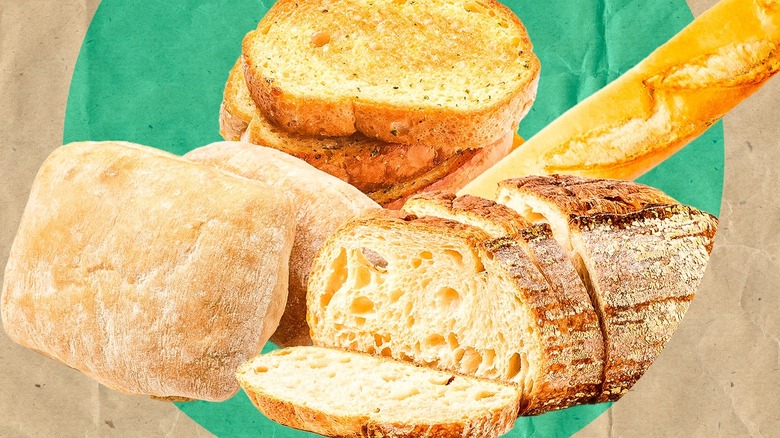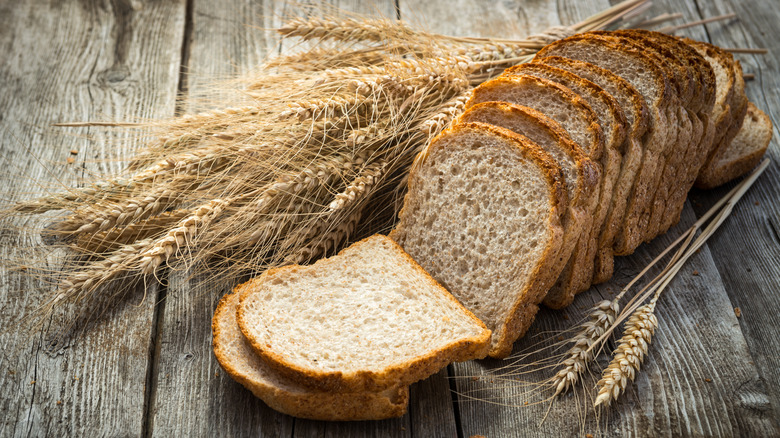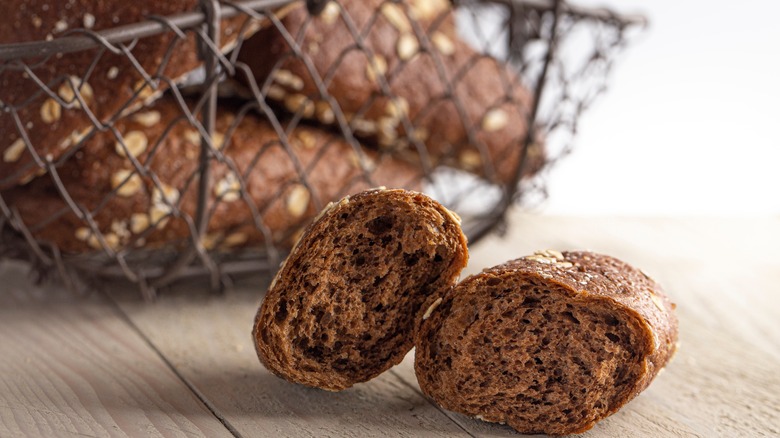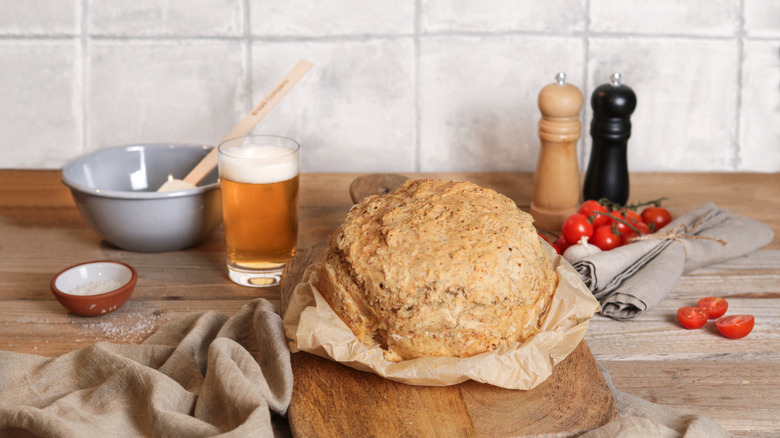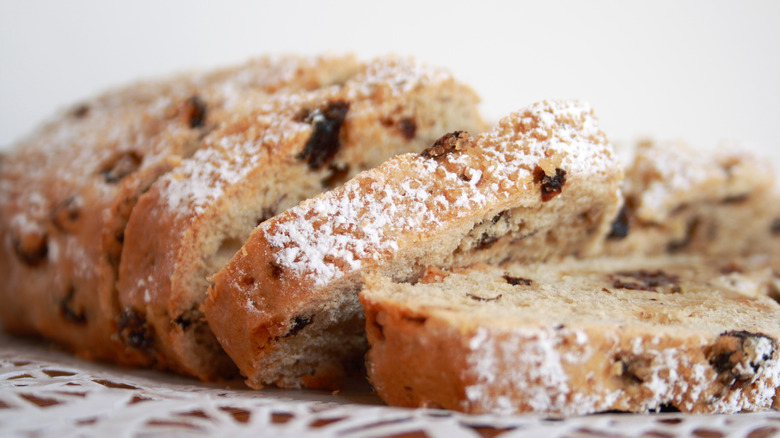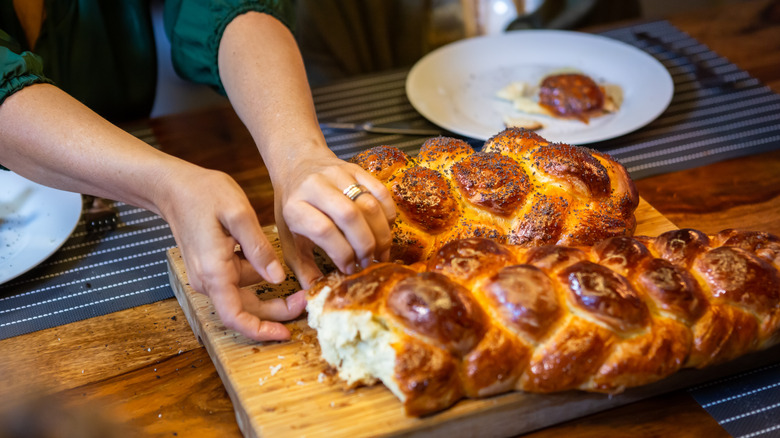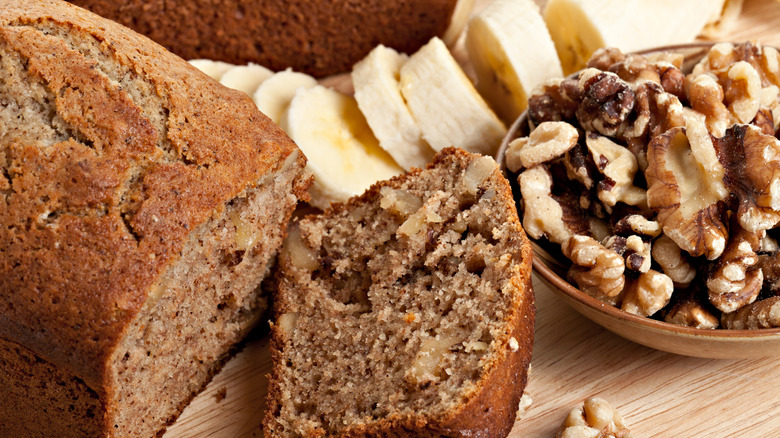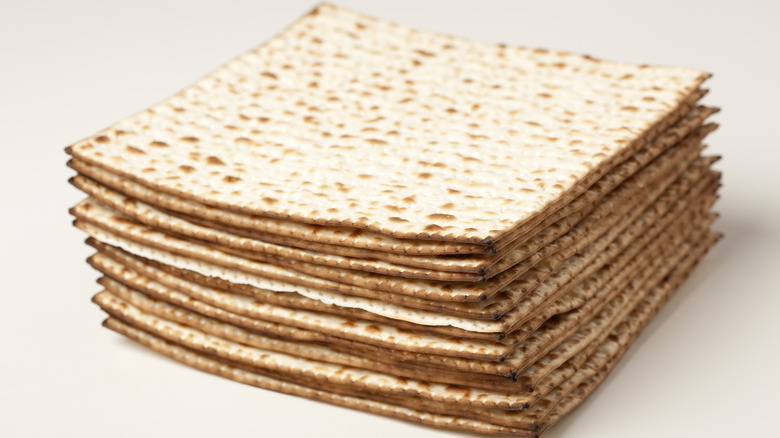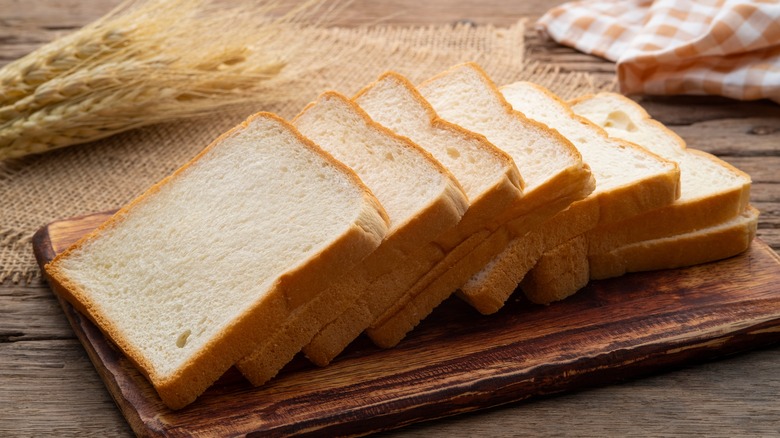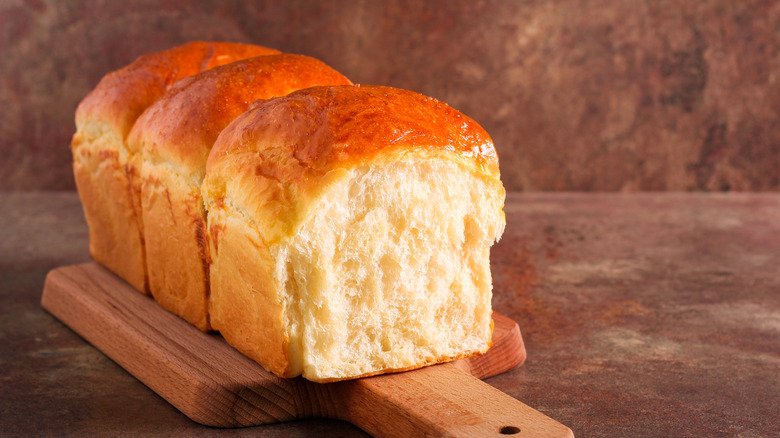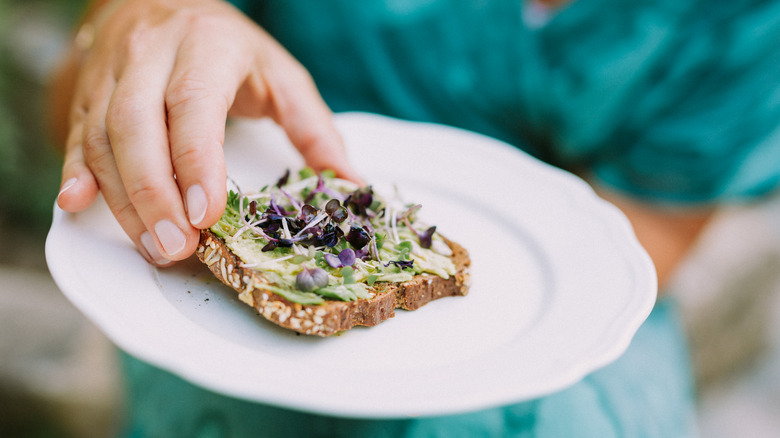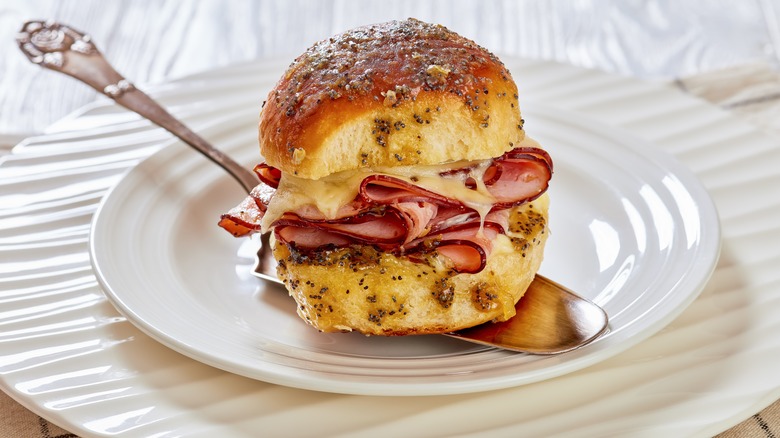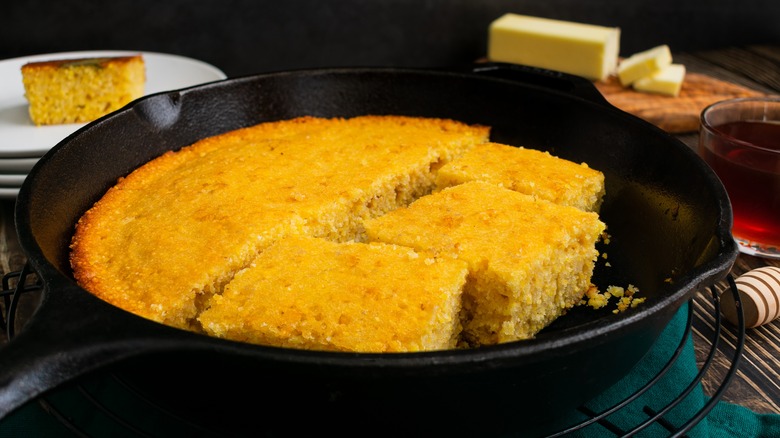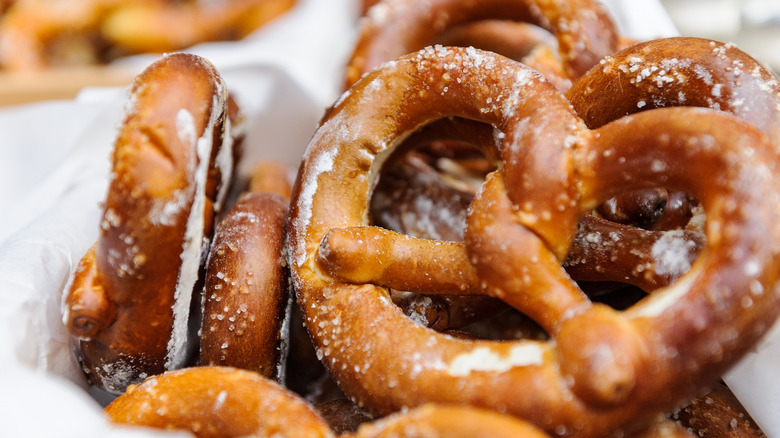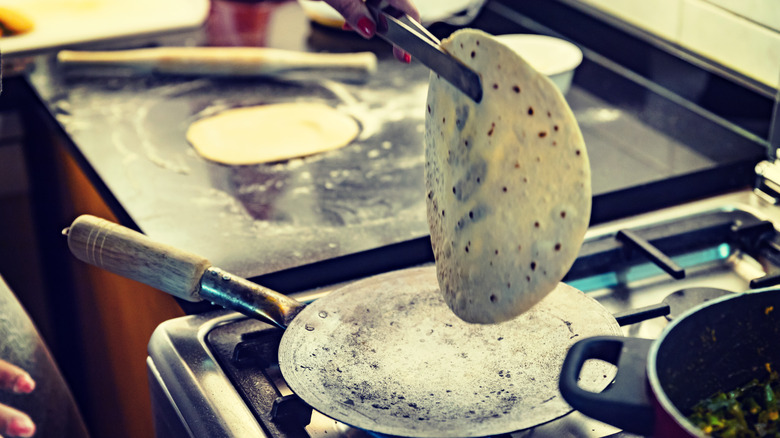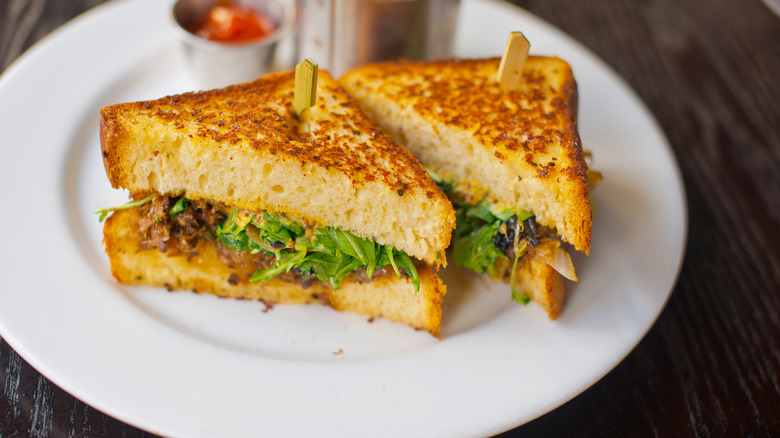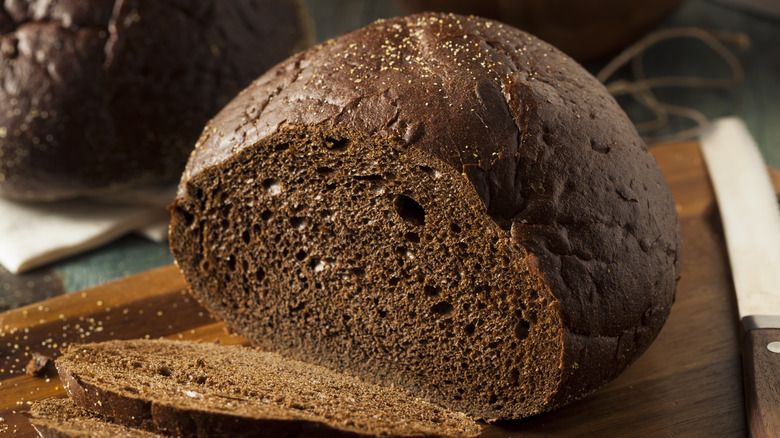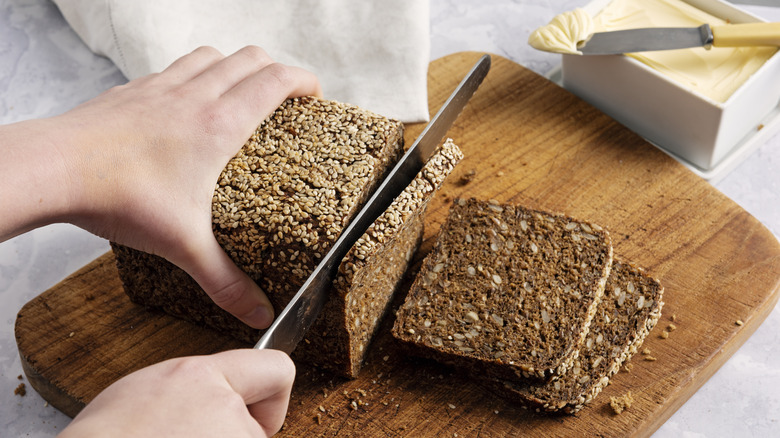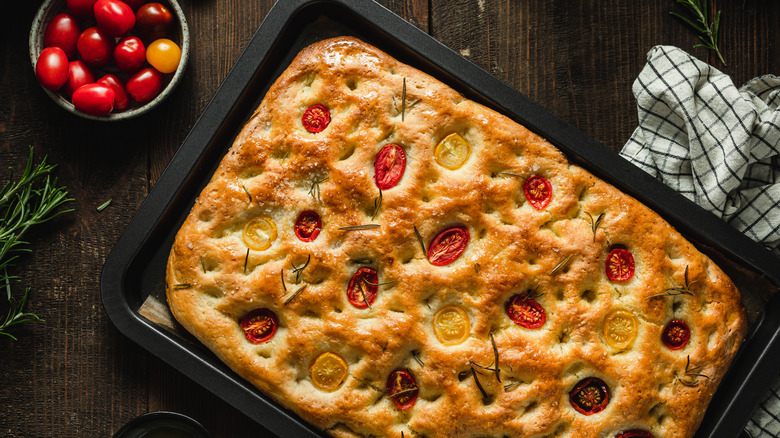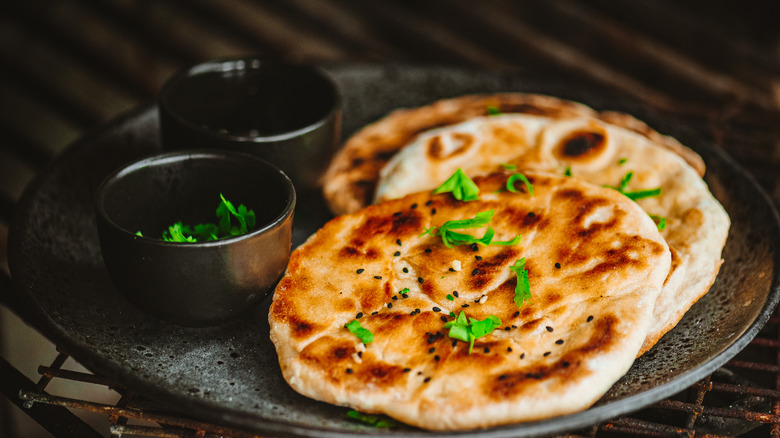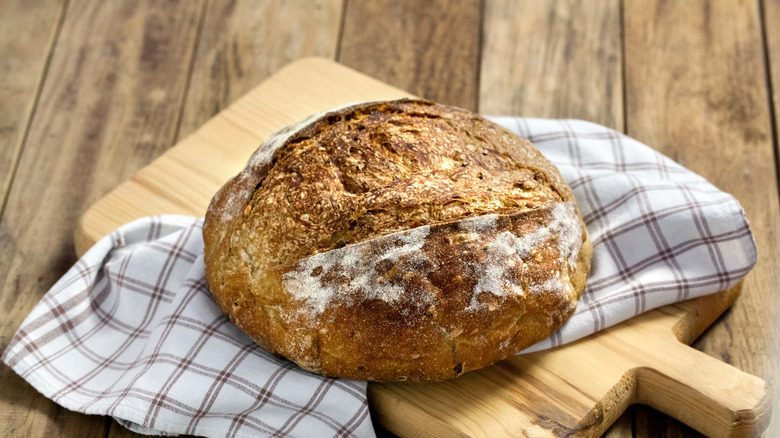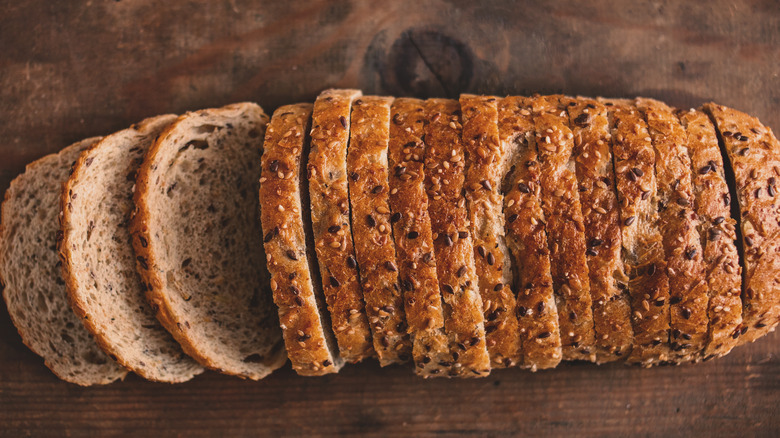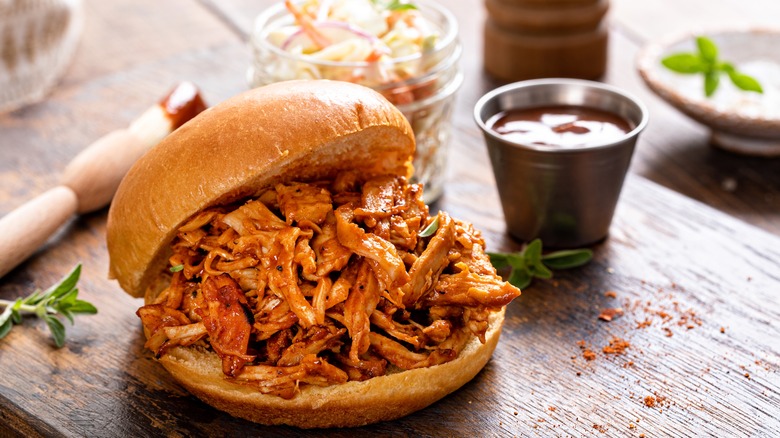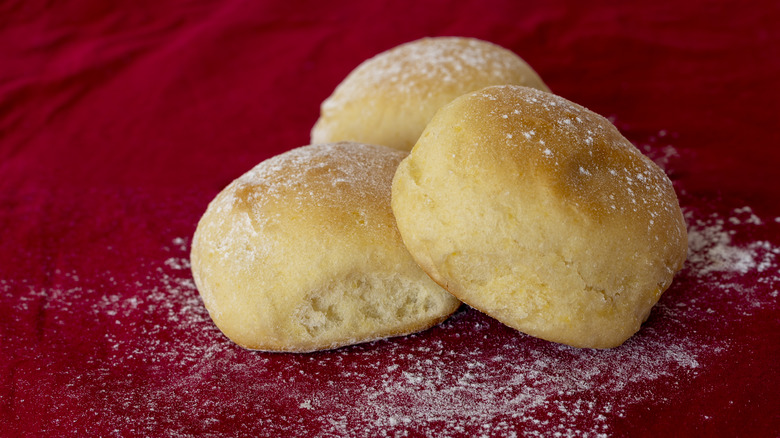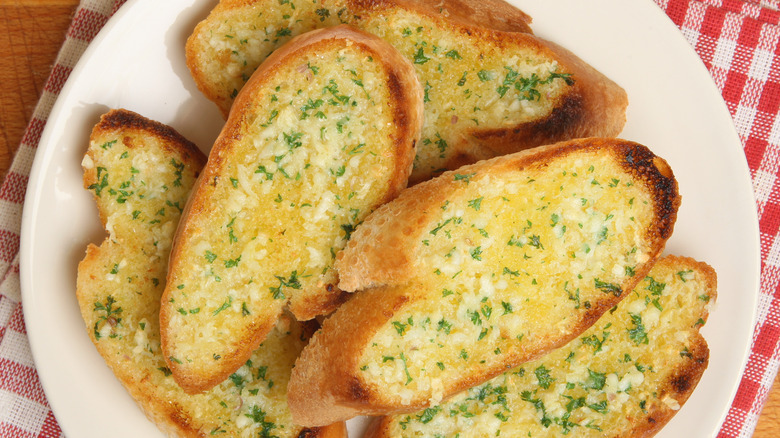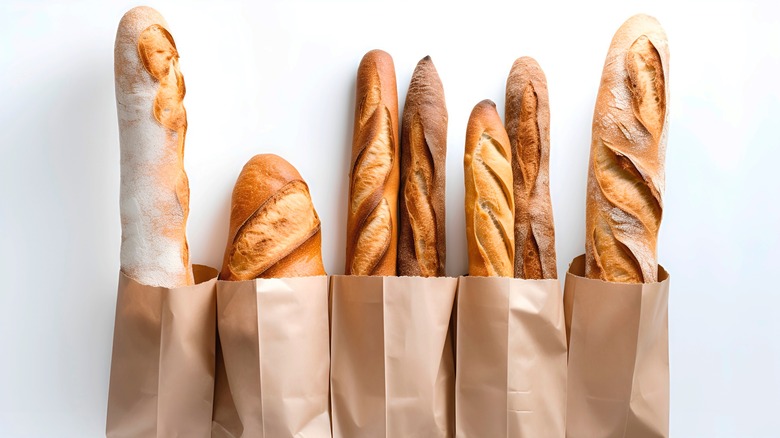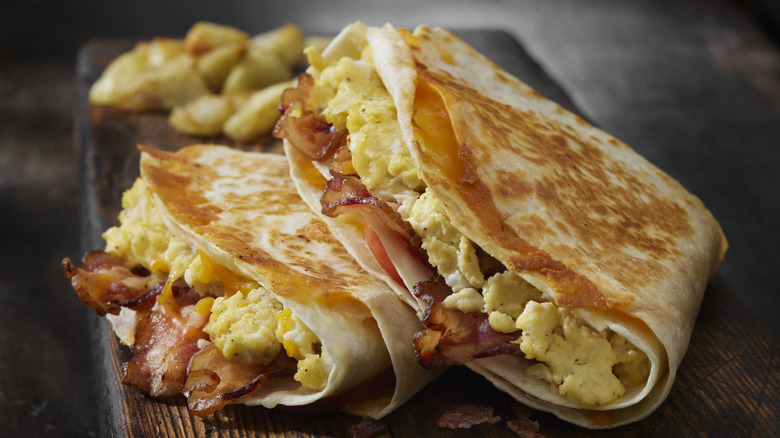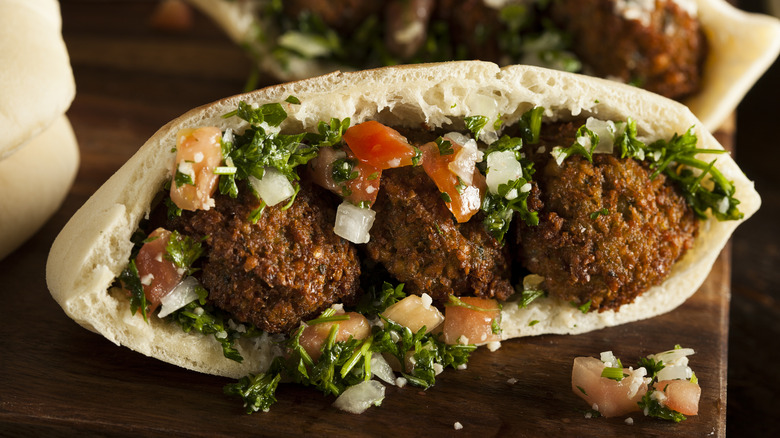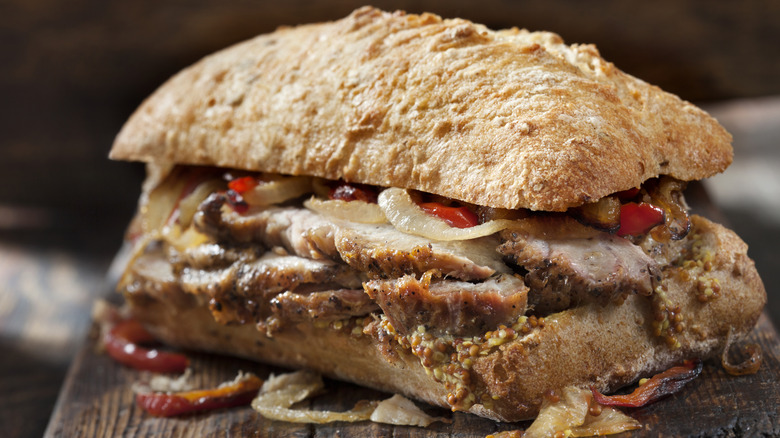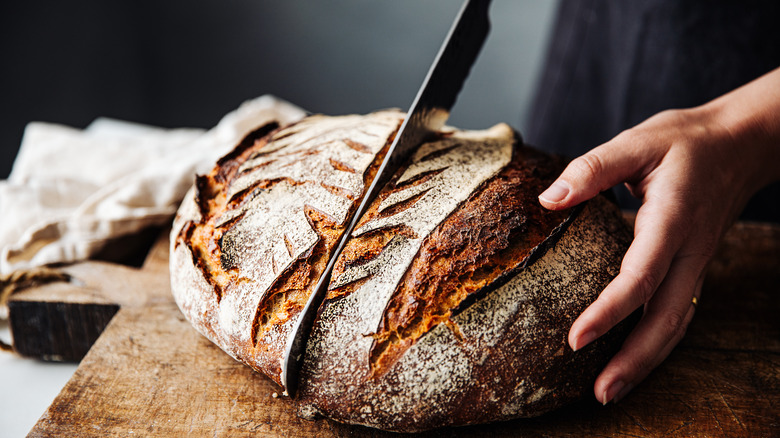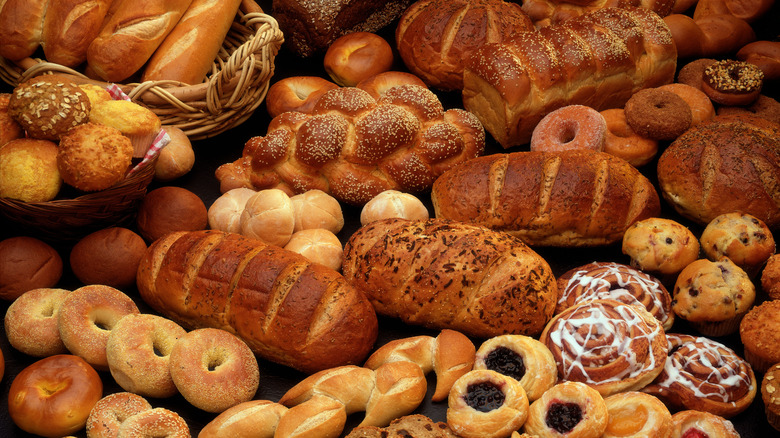29 Types Of Bread, Ranked Worst To Best
We love bread. Although this simple, carby mixture of water, flour, and sometimes yeast may just seem like an accompaniment to your favorite pasta dish or an afterthought in your lunchtime sandwich-making, it's one of life's simplest pleasures and one that we frequently indulge in.
There are just as many different varieties of bread as there are ways to enjoy it. From crunchy ciabatta and oblong baguettes to simple tortillas and twisty pretzels, there's no wrong way to indulge in a slice. However, certain types of bread are more versatile and well-suited for all-around eating than others. In creating this ranking, we weighed several criteria, including how well the bread pairs with sweet and savory ingredients, the mealtimes it is ideal for, and the bread's overall structure and flavor. We've taken the time to research and formulate our own independent opinions about which types of bread are the best and which are not necessarily bad but just less optimal.
29. Wheat bread
Wheat bread is nothing short of an insult. Although it's a common side option at our favorite breakfast spot, we rarely ask for it and instead opt for the white. After all, the only difference between the two is that whole wheat bread is slightly darker. The flavor isn't much different than the white bread, and there's no texture or seeds to it to really elevate it from another type of bread.
But wait, isn't wheat bread healthier than white bread? The jury is still out on that one. Although the consensus is that wheat bread is healthier, some research suggests that your own genetics may have a role in determining whether whole-wheat bread is better for you specifically (via CNN Health).
28. Brown bread
One type of brown bread is often sold in a can and is popular alongside a crock of Boston baked beans. You'll also find this bread on the table at popular restaurants, including Cheesecake Factory.
Molasses gives it a dark hue and a sweet flavor, which makes it a popular choice for breakfast, sandwiches, or just slathered with a pat of butter. But the same ingredient that makes this bread so delicious can also make it distract from the flavors you layer it with. In addition, the molasses makes this bread exceptionally moist and dense, which isn't as appealing as other crispier types of bread.
27. Beer bread
Got hops? This bread does! This type of bread uses beer to provide a carbonated lift to the dough, which gives it the airy qualities of plush quick bread along with a hoppy flavor and aroma. You can also tweak the type of beer you add to the bread to change its taste.
Beer bread is somewhat versatile but won't replace the classic flavor and perfect texture of a yeast-leavened bread. It can be stodgy and dense, even with the beer, which makes it difficult to use outside of eating a slice solo. It's also usually savory, accentuated with ingredients like caraway seeds or cheese, so it has limited utility in sweet applications.
26. Soda bread
Soda bread is a unique quickbread commonly associated with the St. Patrick's Day holiday in the U.S. But there's much more that this bread has to offer. Although it is made with a chemical leavening agent (baking soda), like sweet quick breads, it isn't typically very sweet, instead taking flavor from ingredients like caraway seeds or dried fruit (it's often made plain as well).
This bread can be quite stodgy and dry, which is why we aren't big fans. However, it can be used for sandwiches, eating on its own, or even a unique twist on a classic French toast recipe.
25. Challah
We think that challah is a bit overrated. Although it has an interesting appearance and can be filled with numerous sweet or savory ingredients, it's always bordering on the edge of being just too sweet. In some applications, this flavor, and its spongy consistency, lends itself well to a recipe. It's one of the best types of bread for French toast because it soaks in the custard like a sponge.
However, not all is well in challah-land — especially for folks who attempt to braid it at home. It takes a lot of patience to get it right, and at that point, we recommend just stopping at your local Jewish bakery and buying it instead.
24. Quick bread
Quick bread includes recipes like banana bread, pumpkin bread, and apple bread — what's not to love? This versatile type of bread is leavened with baking soda or baking powder rather than yeast and often takes on a sweet profile. The lack of yeast and its tight crumb structure results in a consistency closer to a cake than bread.
It's best served toasted or slathered with butter but really can't be used for sandwiches or anything that needs more structure. Although some people may use it for French toast, it's as dense as a brick and difficult to get through.
23. Matzo
Matzos are large sheets of unleavened bread symbolically eaten during Passover. The dry bread can also be crushed and made into matzo ball soup or used for desserts like matzo layer cake. In these applications, the thinness of the matzo gives it an advantage. But otherwise, it's not our top pick for sandwiches or morning toast.
If anything, matzo is more of a snack in our household. We'll eat it slathered in a layer of peanut butter and with a drizzle of honey because it distracts from the cardboard-like texture of this bread. Plus, you likely won't find it readily available outside of Passover.
22. White sandwich bread
We owe a lot to white sandwich bread. There's no better vehicle for peanut butter and jelly sandwiches — or the classic New England fluffernutter. But for every other type of sandwich, plain white bread falls flat.
There's no flavor to it (seriously, we can't put a name to what white bread tastes like), and if you go for a cheap, generic brand, there's no guarantee that it will hold up to the weight of your deli meat. Plus, any sort of jelly or condiment is bound to soak through the bread slices and turn your sandwich into a slimy mess.
21. Milk bread
Most people think of this carb as being a vehicle for sweet toppings, but Japanese milk bread is also perfect for sandwiches because it's soft and delicate yet sturdy. Unlike other types of white bread that taste bland, this one pops with buttery notes, making it nothing short of a pleasure to eat.
Despite these positive attributes, milk bread scores relatively low on our list because it's not a bread that we think of eating with dinner or scooping up leftover sauce with. It's also difficult to find unless you frequent Asian markets, but its online popularity may cause more stores to offer it.
20. Sprouted bread
Sprouted bread may be a new-age crunchy concept, but we assure you that this type of bread is as nutritious as it is flavorful. Using sprouted grains, like spelt, increases the bioavailability of certain nutrients, including folate, zinc, and vitamin C (via Harvard Medical School). Sprouted grains also have lower starch levels, so they may be easier to digest than standard bread for some bread enthusiasts.
Besides these nutritional benefits, sprouted grain bread tends to have a nuttier flavor. The addition of seeds also makes this bread texturally more interesting than other types we looked at. However, sprouted bread is rarely available outside of sandwich bread form, which limits its utility.
19. Hawaiian bread
Hawaiian rolls have some shared characteristics with the potato roll. But these yellow-colored rolls tend to be sweeter (thanks to a hefty amount of sugar) and more pillowy. You can use them for sheet pan sliders or make a ham-and-cheese sandwich for a quick afternoon bite.
Although these rolls are delicious, they're not a great all-purpose bread. These buns are really niche in flavor and texture, so you can't use them for every recipe. If you need them for game-day, or even a heavenly French toast, they're great. But they're not as versatile as other varieties of bread.
18. Cornbread
If you visit a Southern restaurant, you're bound to be served a delicious plate of cornbread with your dinner. Not only does cornbread taste great plain, but it can also be infused with flavor, like our honey sage skillet cornbread. The fact that it's entrenched in Southern cooking — and how delicious it tastes when slathered with butter — gives it some brownie points in our book.
But the major downside to cornbread is that it's really only good for eating as a side. If you try to make a sandwich, the slice disintegrates in your fingers and breaks down into tiny pieces that are impossible to pick up.
17. Pretzels
No mall trip is complete without a soft pretzel. These twisty treats have also made their way into the hamburger bun market, where they upgrade the texture of the sandwich with a satisfying chew. Pretzels are often reserved for special occasions or eating outside of the home because making soft pretzels from scratch is a challenge.
Although pretzels are yummy, they're not the best kind of bread out there. While they can be seasoned with rosemary, fennel seeds, and other spices, getting anything to stick to the pretzel is always a challenge. That includes pretzel salt — which is just too coarse and concentrated for our liking.
16. Chapati and roti
Roti and chapati are similar types of flatbread that have different names. They're made thinner than naan and cooked on a flat griddle, called a tawa, rather than in a tandoori. But they share the same utility for soaking up leftover curry.
Although you can ask for a side of this bread from your local Indian restaurant, it's difficult to find in most stores. Plus, these flatbreads are tortilla-like and don't have the same satisfying mouthfeel as a soft, puffy naan. Eating roti with curry often means the food sloshes off to one side or the weight of the filling breaks the flatbread entirely.
15. Texas toast
Everything is bigger in Texas — right? That includes Texas toast, which is essentially just pieces of white bread sliced twice as thick as standard sandwich bread. The larger slice makes for spongier bread, which is perfect for French toast, filling with your favorite sandwich fillings, or transforming into garlic bread.
We think Texas toast is just too much bread for any one person to enjoy. If you're making a sandwich, you want the fillings to stand out — not be completely overcome by bread. Plus, you'll have to do a lot of searching to find a Texas toast that isn't just plain, unflavored bread.
14. Pumpernickel bread
Pumpernickel bread is darker in color and flavor than other types of rye, and it also comes with a smoky, strong undertone that makes it a popular option for sandwiches and toast. It's our go-to pick for a classic Reuben sandwich because the flavors pair well with the corned beef and Swiss cheese.
But because pumpernickel's flavor is so unique and complex, it tends to steal the stage and become the star of the show. It's not a good sandwich if all you taste is the bread. While a pumpernickel dinner roll occasionally hits the spot, it's not a usual loaf we would grab from the grocery store or our local bakery.
13. Rye bread
Rye bread is one of the most aromatic loaves out there. The key ingredient that gives rye bread its unique flavor is caraway seeds, which give the bread a unique citrusy tang with a malty undertone. The rye grain itself gives the bread a moist consistency and less chewy bite because of its low gluten content. It doesn't have the strong profile of pumpernickel, which means you can use it for plain deli sandwiches like ham or turkey.
We also like eating rye toast with our breakfast because it has a bit more pizazz than white bread alone. Otherwise? There's not much this bread is useful for.
12. Focaccia
Focaccia art is so much better than regular art. And the taste is probably much better, too. The ideal homemade focaccia features a coating of olive oil on its dimpled skin, which essentially causes the outside of the bread to fry in the oven. Plus, it's often coated with a sprinkle of herbs or sea salt, which adds to the experience of eating this delicious Italian loaf. While we love this bread plain with rosemary and flaked salt, it can also be dotted with onions, peppers, and roasted tomatoes.
Although focaccia is our go-to for a side, it's not our ideal option for a sandwich. Plus, focaccia on day two just isn't great.
11. Naan
We love running a piece of garlic naan through the bottom of our bowl of curry or tikka masala. This Indian flatbread has a slight rise to it and perfectly charred flecks caused by the heat of the tandoor that it's cooked in. Naan can be eaten both solo as a side or as a utensil with Indian food, but it's rare to see it used as an accompaniment outside of that regional cuisine. Unlike roti, naan is widely available in grocery stores.
The biggest impediment to naan's carby takeover is its lack of versatility — we wouldn't choose it for a deli sandwich or as a side with Italian food, for example.
10. Boule
Boule is a simple French bread (the name translates to "round"). This yeasted loaf can be made with virtually any type of flour and is often baked in a wood-fired oven to give it a beautiful brown hue and crusty exterior.
We love this loaf because it's airy and light, but it doesn't have the best ratio of crackly exterior to soft, plush interior. However, you can use it to dip into a flavored oil or swipe up the leftover sauce on your dinner plate. You could also slice it up and use it to replace your boring white bread, but the crust can be a workout to bite through.
9. Multigrain bread
Multigrain and whole-wheat bread are different. It requires a careful eye to choose one over the other. Multigrain bread tends to have whole pieces of grains, including barley, oats, sesame seeds, and poppy seeds. These grains really uplift the texture of the bread and give it a more rustic flavor. Plus, you can find multigrain rolls and bagels too.
However, depending on what you're eating, the seeds may distract from the texture of the rest of the bread. In short, it's a great bread to eat as toast or for when your sandwich is looking for something a little more exciting, but it isn't great for eating with dinner.
8. Brioche
Brioche has made a name for itself on the bread scene. An authentic brioche is made with enriching ingredients like flour, butter, and sugar, which gives it a sweet taste and plush texture, unlike traditional bread, which is just made with flour, water, salt, and yeast. These fatty ingredients also give the bread a beautiful, shiny luster.
Brioche wins versatility points because it can be made into sandwich bread, buns, and more. Plus, you can eat it with both sweet and savory toppings and fillings. However, brioche doesn't take our top spot because some savory accompaniments, like pasta, don't work at all with it.
7. Potato bread
Potato bread is like white sandwich bread but with a step up. Not only is it easily sliceable with the same degree of softness as white bread, but it has a much more profound flavor. But you don't have to worry because this type of bread doesn't taste like a bowl of mashed potatoes or a starchy french fry. Plus, its sturdiness and structure make it ideal for topping with an avocado schmear, ham and cheese, or chicken salad.
It's a versatile bread that is widely available in slider buns, sandwich bread, and more. Therefore, it has more utility than other types of breads we reviewed.
6. Garlic bread
We mean it: We want to give a big kiss to the person who decided it was a good idea to slather slices of bread with a mixture of chopped garlic and butter (and occasionally herbs). If given the choice between all the side dishes in the world (besides tater tots), we would choose the garlic bread every time.
The flavors and structure of this bread rule it out from every sweet application. But we love that you can use an array of breads for the base, including baguettes, Italian loaves, grinder rolls, and even plain sandwich bread.
5. Baguettes
A little baguette poking out of a brown paper bag is as aesthetically pleasing as it is delicious. The perfect baguette has a crispy, crackly crust that is relatively difficult to sink your teeth into. Meanwhile, the inside is a perfect consistency — soft and pliable — that is just begging for a spread of Boursin cheese or butter. And don't count baguette out of the French toast race either — it makes a pretty darn good casserole bake.
Baguettes are a classic type of bread, but the shape of these loaves is rather limiting. Plus, the texture of the bread can make it hard to bite into a sandwich.
4. Tortillas
You can't make a quesadilla with a baguette or sandwich bread, so adding tortillas to our bread rankings seems right. This flatbread is a staple for Mexican favorites like tacos, enchiladas, and others, but it also makes it possible for us to eat ungodly amounts of chicken Caesar salad wraps.
Although tortillas are versatile in the kitchen, they don't replace the feeling of biting into a crusty piece of bread. But for folks who want the filling to be the star of the show rather than the bread, these wraps are a must-have.
3. Pita bread
Pita bread: It's all about the pocket. This flatbread is a step above what other wraps offer because you will never have to worry about tucking your fillings all neat and tidy inside a tightly wrapped tortilla. Instead, you can open the pita and stuff your favorite fillings inside.
Although Mediterranean food like falafel, hummus, and tabouleh is a common choice for stuffing pitas, you can also use this bread for other recipes. For example, imagine never worrying about burger fillings falling down the side of your hand or mustard sloshing off your pastrami and onto your lap.
2. Ciabatta
Ciabatta is for folks who love artisan bread — and still want a shape that they can work with. This Italian bread was invented to spite the French and can be used to soak up good olive oil or as a vehicle for your favorite sandwich. We also love using it for our breakfast sandwiches because it has the perfect balance of spongy inside to crisp exterior.
We can't really find any fault with ciabatta, but there is one variety of bread that is just ... well ... better. Our top pick was more exciting in flavor than the ciabatta, but ciabatta is still one of our go-to's from the bakery.
1. Sourdough
Our top-performing bread, which we will continue to choose every single time, is unequivocally sourdough. Although it's a pain in the neck to keep a sourdough culture alive and thriving, the flavor you get from this bread is totally worth it. Every sourdough culture is different, so you may get flavors that are malty, salty, or just plain funky. Plus, many sourdough bread recipes are crusty and embellished with beautiful designs.
Sourdough can also be used for other purposes, like making the best bagels or giving your pizza dough a flavorful twist. Who knew a microbial community of yeast and bacteria could do this much for the bread world?
Methodology
With so many different types of bread, how could we heartlessly rule one over the rest? The characteristics we looked for in outstanding bread were versatility for eating at different times of day as well as the ability to pair it with both sweet and savory ingredients. We also examined the structure of the bread. For example, white sandwich bread can do an awful job of not falling apart when stuffed with wet ingredients, while a pita can withstand being loaded with toppings and also soak up hummus on a plate.
Lastly, we examined taste. Does the bread elevate a dish, or does it merely distract from the other ingredients at play? Does it taste good on its own, or does it need toppings?
